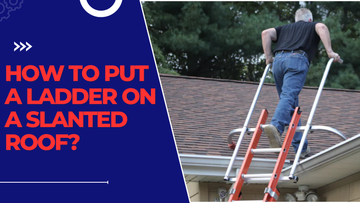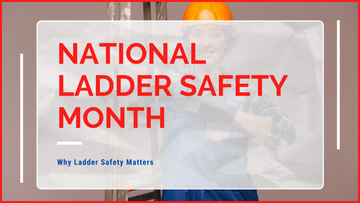
Working on a slanted roof is never easy, but it’s something many individuals do almost on a daily basis. Tasks like cleaning gutters, repairing shingles, installing holiday lights, or inspecting the roof for damage all require climbing up and working at dangerous heights. Knowing how to put a ladder on a slanted roof safely is essential to avoid accidents and injuries.
Sloped surfaces are quite unpredictable. They make the ladder more likely to slip, tilt, or collapse if not set up correctly. Bad weather conditions, like rain, ice, or high winds, can make the situation even more hazardous. Using the right tools and techniques, such as a ladder stabilizer, and ladder safety rail, can significantly reduce the risk of accidents.
In this guide, we will walk you through everything you need to know about setting up a ladder on steep roof surfaces. From choosing the best ladder for steep roof work to understanding how to stabilize a ladder on a roof, we’ll cover it all.
Why Using a Ladder on a Slanted Roof Is Risky
Slanted roofs increase the risk of accidents. Using a sloping roof ladder system is a must when working on uneven surfaces.
Rain, ice, or strong winds can make the roof even more dangerous. The risk of slipping increases when the ladder is not secured properly. Taking the right steps to secure ladder to roof can save you from accidents.
Things You Need to Work Safely on a Slanted Roof
To work safely on a slanted roof, you will need:
-
Extension Ladder – A strong, durable ladder for steep roof work. When using an extension ladder without additional safety accessories, it should extend three feet above the roof’s edge. However, when using a ladder safety rail, it acts as an extension, ensuring compliance with the three-rung rule.
-
Ladder Leveler – A device that helps keep the ladder stable on uneven ground.
-
Ladder Stabilizer – A tool that stops the ladder from moving sideways and protects gutters.
-
Roof Ladder (Hook Ladder) – A roof ladder that hooks over the roof ridge for extra safety.
-
Safety Harness and Rope – Essential for fall protection while you climb roof safely.
-
Non-Slip Shoes – Helps prevent slipping while working.
Step-by-Step Guide to Putting a Ladder on a Slanted Roof

Step 1: Choose the Right Ladder:
Use a strong extension ladder for slanted roofs. It should be sturdy enough to support your weight. If using a ladder safety rail, the ladder itself does not need to extend three feet above the roof edge, as the safety rail provides the required extension for compliance
If you are working near power lines, choose a fiberglass ladder instead of metal to avoid electric shocks. Also, using a ladder safety rail can provide extra stability when climbing.
Step 2: Inspect the Ladder:
Always inspect your ladder before using it. Check for any cracks, dents, or damaged parts. Make sure the rungs are clean and not slippery. The locks and hinges should be working properly. Damaged ladders should never be used.
Step 3: Prepare the Ground:
Set the ladder on solid, flat ground. If the surface is uneven, use a ladder leveler to keep it steady. The base of the ladder should be placed one-quarter of the ladder’s height away from the building. This angle helps stabilize the ladder and prevents it from tipping.
Step 4: Attach Ladder Stabilizers:
Using a ladder stabilizer at the top of the ladder helps prevent sideways movement. It also protects the gutters from getting damaged. This is a crucial step when learning how to stabilize a ladder on a roof.
Step 5: Secure the Ladder to the Roof:
To prevent the ladder from slipping, secure ladder to roof by tying it to a sturdy object or using ladder safety stakes. Using a ladder safety rail or ladder safety system can also improve stability.
Step 6: Climb the Ladder Safely:
When you climb roof safely, always face the ladder and keep three points of contact. Never lean to the side or try to reach too far. Instead, move the ladder as needed.
How to Use a Roof Ladder (Hook Ladder)
If you need to work directly on the roof, using a roof ladder is essential. Here’s how to do it:
-
Attach the Hooks: Connect the hooks to the top of the ladder before lifting it.
-
Lift and Slide: Carefully lift the ladder and slide it up the roof.
-
Secure Over the Ridge: Place the hooks over the roof’s ridge to lock the ladder in place.
-
Check Stability: Gently pull the ladder to make sure it’s secure.
Safety Tips for Using a Ladder on a Slanted Roof
-
Always Wear a Safety Harness: Attach your harness to a secure point to prevent falls.
-
Check Weather Conditions: Never work on a wet, icy, or windy roof.
-
Use Proper Ladder Safety Devices: Tools like ladder levelers, ladder stabilizers, and safety rails make your work much safer.
-
Avoid Overloading the Ladder: Keep tools light and manageable.
-
Use Non-Slip Shoes: Shoes with good traction prevent slipping.
-
Have an Assistant: Having someone around to help can save you from accidents.
Common Mistakes to Avoid
-
Using a Damaged Ladder: Always check your ladder before use.
-
Setting the Ladder at the Wrong Angle: The ladder should form a 75-degree angle with the ground.
-
Ignoring the Weather: Wet or windy conditions make the job much more dangerous.
-
Overreaching: Never stretch too far to the side. Move the ladder if needed.
-
Skipping Safety Gear: Not using a safety harness or ladder safety devices can lead to severe accidents.
Conclusion:
Learning how to put a ladder on a slanted roof is all about using the right tools and following safe practices. From choosing the best ladder for steep roof work to understanding how to secure ladder to roof properly, each step matters. If using a ladder safety rail, remember that it serves as an extension, helping you meet safety regulations without needing the ladder itself to extend three feet above the roofline.
Always check your ladder, secure it with ladder safety devices, and make sure you’re using a roof ladder if you’re working directly on the roof. Remember to double-check everything before climbing, especially if you’re working on a ladder on steep roof conditions.
By following these steps and using the right ladder safety rail and ladder safety system, you can get your work done safely and without stress.
Why Choose Ladder Safety Rails?
Protect yourself while working on slanted roofs with the Ladder Safety Rails Ladder Stabilizer for Roof and Hand Rail System. This top-quality stabilizer is designed to provide superior stability and safety, allowing you to work confidently even on steep surfaces. Additionally, the Original Softouch Bumpers offer a non-slip grip, ensuring your ladder stays secure without damaging surfaces. With added handrails for extra support, you can climb roof safely and avoid dangerous slips or falls. Invest in your safety—choose Ladder Safety Rails today!
FAQs:
-
How to use a ladder on a pitched roof?
Use a ladder stabilizer and secure the ladder base. Ensure a 75° angle, keep three points of contact, and use a safety harness for extra protection.
-
How to safely work on a slanted roof?
Use a safety harness, non-slip shoes, and roof ladder. Secure the ladder base, and ensure stable footing. Avoid working in bad weather.
-
How do you walk on a slanted roof?
Wear non-slip shoes, use a roof ladder, and keep your weight balanced. Always move slowly and avoid sudden movements to prevent slipping.
-
How do you find the angle of a slanted roof?
Measure the rise (vertical height) and the run (horizontal distance), then use the formula: angle = arctan(rise/run) to find the roof angle.
Read More Blogs:




